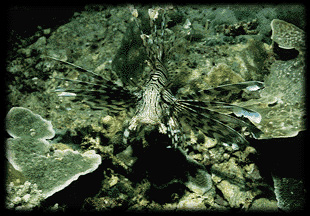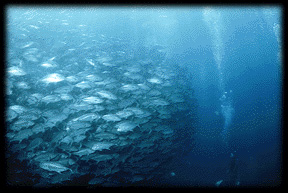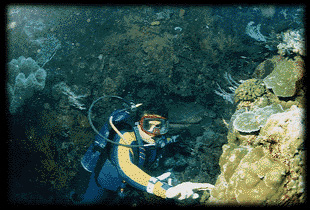

Attention all divers. If you are looking for a place that is hard to get to and is still in pristine condition, read on. Borneo Divers has the key to turtle heaven. They run an efficient dive operation on the tiny island of Sipadan, in Malaysia. It is a speck - about a mile in circumference - but its underwater world is the proverbial Garden of Eden.
My first dive was a 50' wall dive. Into the 18th minute of the dive I had
already seen 22 turtles. That's more than a turtle a minute!

We saw white tip sharks, large bump head parrot fish, approximately three to four feet long and in schools of more than a hundred fish. As well as thousands of schooling barracudas and jacks, are present in just about every dive. When the gods wanted an aquarium, they created Sipadan.
Jacques Cousteau said of Sipadan, "I have seen other places like Sipadan ... 45 years ago. Now again we have found an untouched piece of art."
On Sipadan I witnessed all forms of turtle behaviours. At six in the morning I walked around the island and saw 10 fresh turtle tracks in the sand leading to their nests near the tree line on shore. No one is allowed to walk around the island from 7pm to 6am. The reason became quite apparent when I witnessed three newly hatched turtles struggling to make their way to the sea.
A human foot print in their path would be an obstacle as large as a crater on the moon.
The next morning I saw a large female turtle mating on the surface, while two younger males circled in the vicinity waiting for their turn. All this from the deck of my hut. On my dives, I watched green turtles feeding on soft corals and others resting while pilot fish cleaned their shell. Wesley Wong, operations supervisor for the dive lodge, took me to the 'turtle tomb'. There he pointed out 20 to 30 large skeletal remains of very old green turtles. In the Cayman Islands and in Cozumel, you could find yourself lucky to see one or two mid-sized turtles swim by you in the distance. On Sipadan, you witness all aspects of their being.
The island is very beautiful above the surface. I sat in my thatched hut on the veranda looking at the ocean beneath me. At high tide, the four stilts of my hut kept the ocean from the floor, as it roared under my feet. I could look out after a glorious day of diving and see powdery white sand, an emerald ocean and a lush rain forest in the center. At sunset, I noticed that the most feared creature of the night - the mosquito - hadn't appeared. Unlike other dive spots, the insect population seems scarce.

My dive buddies are Japanese, Swedish and American. When I told the American I would be writing an article about my trip, he wasn't too happy. This was his third trip here and his comment was "Just what we need - more divers coming to paradise. It will become just like the Caribbean, beautiful blue water and no marine life."
The standard rule of thumb, more divers equals less fish just does not apply in Sipadan. In fact, there has been an increase in the fish population during the last three years, according to Dr. Elizabeth Woods, a marine biologist who has been coming to Sipadan since 1989. She states that the increase in sport diving has put a stop to dynamite fishing and gill netting in the area. Diver operators believe that this has led to more fish from the surrounding ravaged reefs coming to the protected waters of Sipadan.
Borneo Divers and Seasports was the first dive operation on the island. They run a smooth operation. The staff are courteous and helpful. The meals are fresh and healthy. Minori, my dive master, was a gem. She was a young lady of 28, who visited Sipadan after she completed her BA in Japanese literature in Japan. She fell in love with Sipadan and is now working here full time. Minori takes the rules to protect the environment seriously.
On Sipadan I witnessed the final stage in the evolution of sport diving. It started out with spear fishing, to feeding the marine life (where dive operators have pet moray eels, potato cods and dolphins) to the present policy of no-feeding, no-touching. This hands-off rule is practiced religiously by Borneo Divers. Thanks to Ron Holland, Sipadan is no Stingray City. Like most things today, we have to come to Asia to find out the current trends in sport diving. The belief that the sea is one of the truly wild places left on this earth, so let's keep it that way. No cheese whiz please!
 Ron Holland believes the pay off is the noticed change in
turtle behaviour. Over the years, they used to stay about 10 feet away from
the divers, but today they swim right by you. I could have on many of my dives
reached out and touched one, or even grabbed it and ridden on its back. But
coming here and seeing the results of the no-touch and no-feed philosophy
has made me a born-again diver.
Ron Holland believes the pay off is the noticed change in
turtle behaviour. Over the years, they used to stay about 10 feet away from
the divers, but today they swim right by you. I could have on many of my dives
reached out and touched one, or even grabbed it and ridden on its back. But
coming here and seeing the results of the no-touch and no-feed philosophy
has made me a born-again diver.
Why did I call this article Turtle Tracks? Not because of the abundance of turtles on Sipadan, but because of the profound memories the turtles of Sipadan have left in my mind. This saw me through the three more months of winter I had to endure on my return home.
Knowing that there are Sipadans out there, even when I am stuck in the cold, winter-bound city, sustains something within me. It gives me something I cannot find anywhere else. I've looked and did not know I needed it until I experienced it. Paradoxically, nature doesn't just regenerate forest and eco-systems, it regenerated me.
Editor's Note: Getting to Sipadan isn't easy. After flying to Kuala Lumper and Kota Kinabalu you stay overnight so you can catch the 6am flight to Tawau (45 minutes). Then it's a two-hour bus ride to Semprana and a hour ferry boat ride to Sipadan.
BY CHRISTOPHER FERNANDEZ
Copyright 1998 - 2000